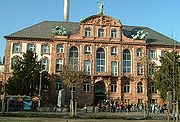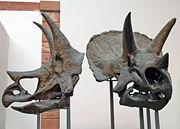
Senckenberg Museum
Encyclopedia

Frankfurt
Frankfurt am Main , commonly known simply as Frankfurt, is the largest city in the German state of Hesse and the fifth-largest city in Germany, with a 2010 population of 688,249. The urban area had an estimated population of 2,300,000 in 2010...
is the second largest museum of natural history in Germany
Germany
Germany , officially the Federal Republic of Germany , is a federal parliamentary republic in Europe. The country consists of 16 states while the capital and largest city is Berlin. Germany covers an area of 357,021 km2 and has a largely temperate seasonal climate...
. It is particularly popular with children, who enjoy the extensive collection of dinosaur
Dinosaur
Dinosaurs are a diverse group of animals of the clade and superorder Dinosauria. They were the dominant terrestrial vertebrates for over 160 million years, from the late Triassic period until the end of the Cretaceous , when the Cretaceous–Paleogene extinction event led to the extinction of...
skeletons: Senckenberg boasts the largest exhibition of large dinosaurs in Europe. One particular treasure is a dinosaur fossil with unique, preserved scaled skin. The museum contains the world's largest and most diverse collection of stuffed birds with about 2000 specimens. In 2004, almost 400,000 people visited the museum.
The building housing the Senckenberg Museum was erected between 1904 and 1907 outside of the center of Frankfurt in the same area as the Johann Wolfgang Goethe University
Johann Wolfgang Goethe University of Frankfurt am Main
The Goethe University Frankfurt was founded in 1914 as a Citizens' University, which means that, while it was a State university of Prussia, it had been founded and financed by the wealthy and active liberal citizenry of Frankfurt am Main, a unique feature in German university history...
, which was founded in 1914. The museum is owned and operated by the Senckenberg Nature Research Society, which began with an endowment by Johann Christian Senckenberg
Johann Christian Senckenberg
Johann Christian Senckenberg was a German physician , naturalist and collector.In 1763 he established the Senckenberg Foundation to support natural sciences...
.
Today, visitors are greeted outside the building by large, life-size recreations of dinosaurs, which are based on the latest scientific theories on dinosaur appearance. Inside, one can follow the tracks of a Titanosaurus
Titanosaurus
Titanosaurus is a genus of sauropod dinosaur, first described by Lydekker in 1877. It is known from the Maastrichtian Lameta Formation of India...
, which have been impressed into the floor, towards its impressive skeleton on a sheltered patio.
Attractions include a Parasaurolophus
Parasaurolophus
Parasaurolophus is a genus of ornithopod dinosaur that lived in what is now North America during the Late Cretaceous Period, about 76.5–73 million years ago. It was an herbivore that walked both as a biped and a quadruped. Three species are recognized: P. walkeri , P. tubicen, and the...
with its crest, a fossilized Psittacosaurus
Psittacosaurus
Psittacosaurus is a genus of psittacosaurid ceratopsian dinosaur from the Early Cretaceous Period of what is now Asia, about 130 to 100 million years ago. It is notable for being the most species-rich dinosaur genus...
with clear bristles around its tail and visible fossilized stomach contents, and an Oviraptor
Oviraptor
Oviraptor is a genus of small Mongolian theropod dinosaur, first discovered by the paleontologist Roy Chapman Andrews, and first described by Henry Fairfield Osborn, in 1924...
. Big public attractions also include the Tyrannosaurus rex
Tyrannosaurus
Tyrannosaurus meaning "tyrant," and sauros meaning "lizard") is a genus of coelurosaurian theropod dinosaur. The species Tyrannosaurus rex , commonly abbreviated to T. rex, is a fixture in popular culture. It lived throughout what is now western North America, with a much wider range than other...
, an original of an Iguanodon
Iguanodon
Iguanodon is a genus of ornithopod dinosaur that lived roughly halfway between the first of the swift bipedal hypsilophodontids and the ornithopods' culmination in the duck-billed dinosaurs...
, and the museum's mascot, the Triceratops
Triceratops
Triceratops is a genus of herbivorous ceratopsid dinosaur which lived during the late Maastrichtian stage of the Late Cretaceous Period, around 68 to 65 million years ago in what is now North America. It was one of the last dinosaur genera to appear before the great Cretaceous–Paleogene...
.

History of Earth
The history of the Earth describes the most important events and fundamental stages in the development of the planet Earth from its formation 4.578 billion years ago to the present day. Nearly all branches of natural science have contributed to the understanding of the main events of the Earth's...
. For example, the museum houses a large number of originals from the Messel pit
Messel pit
The Messel Pit is a disused quarry near the village of Messel, about southeast of Frankfurt am Main, Germany. Bituminous shale was mined there. Because of its abundance of fossils, it has significant geological and scientific importance...
: field mice, reptiles, fish and a predecessor to the modern horse
Evolution of the horse
The evolution of the horse pertains to the phylogenetic ancestry of the modern horse from the small dog-sized, forest-dwelling Hyracotherium over geologic time scales...
that lived about 50 million years ago and stood less than 60 cm tall.
Unique in Europe is a cast of the famous Lucy, an almost complete skeleton of the upright hominid Australopithecus afarensis
Australopithecus afarensis
Australopithecus afarensis is an extinct hominid that lived between 3.9 and 2.9 million years ago. A. afarensis was slenderly built, like the younger Australopithecus africanus. It is thought that A...
. Historical cabinets full of stuffed animals are arranged in the upper levels; among other things one can see one of twenty existing examples of the quagga
Quagga
The quagga is an extinct subspecies of the plains zebra, which was once found in great numbers in South Africa's Cape Province and the southern part of the Orange Free State. It was distinguished from other zebras by having the usual vivid marks on the front part of the body only...
, which has been extinct since 1883.
Since the remodeling finished in 2003, the new reptile exhibit addresses both the biodiversity of reptiles and amphibians and the topic of nature conservation. An accessible rain forest tree offers views of different zones of the rain forest from the ground to the tree canopy and the habitats to which the exotic reptiles have adapted.
The Senckenberg Museum offers regular evening lectures and tours.
External links
- Museum website including information in English
- Flickr Photos of specimens on the galleries, interior and exterior views.

